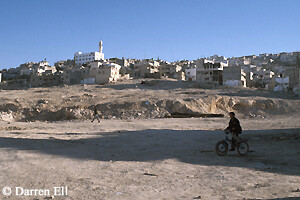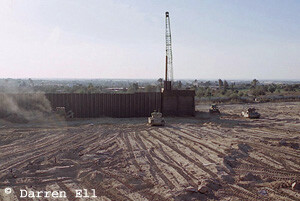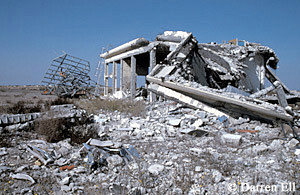
Above: Cover of The New Intifada. Buy this book on Amazon.com
“During his successful election campaign in 1999, Ehud Barak ran on a platform of “Peace Through Separation: We Are Here; They Are There”…. “Barak’s vision of separation was to be achieved through the construction of checkpoints, walls, fences, trenches, bridges, canals, and tunnels.”This vision, a nightmare which the Palestinian Authority could no longer ignore by 2000, corresponds to the reality I witnessed in the West Bank and Gaza.
After staying in the Old City in Jerusalem where everyone’s movements are tracked by video cameras on every corner, I ventured to Ramallah with a Canadian international worker. We entered the encircled city through a small checkpoint we reached via a circuitous route, the main road having been destroyed by bulldozers.

Above: Qalandia checkpoint. A bottleneck of misery for tens of thousands of Palestinians.
Later I took a taxi to Birzeit University to talk to students. Most of the students I met were from Gaza. They were all pining for their families. They hadn’t been allowed home in 2 years (Gaza is only 90 minutes by car from Ramallah) since the closure of the territories at the beginning of the Al-Aqsa Intifada. Sara Roy tells a similar though more dramatic story of separation in her essay in The New Intifada:
“The physical division of the West Bank has become so pronounced that families living in the northern region do not want their children to marry spouses from the southern region because they fear they will not be able to see them (even though the distance between the north and south West Bank is no more than forty miles).”The next day, I went to Jenin with a Canadian medical team. We traveled through the Jordan Valley to avoid the numerous checkpoints in the West Bank that turn a one-hour journey into a daylong event. Jenin too was surrounded, with tanks blocking every entrance to the city. Jenin had just come out of a prolonged 24-hour curfew. The residents were nervous and hesitant to circulate in the streets. I was told to avoid the refugee camp where people were traumatized by frequent IDF incursions. On my second morning in Jenin, the IDF surrounded houses in the camp and shot dead a suspected Islamic Jihad member as he fled the soldiers. His brother was critically wounded in the shooting.

Above: “Ground Zero” in Jenin.
The next morning, we picked up Palestinian physicians at the Ministry of Health to transport them to outlying villages cut off from health care because of IDF closures. Without our car, the doctors could not leave Jenin. Getting past the tanks required a passport check and a verification of our carefully prepared list of the car’s occupants. To access one of the villages, we had to leave the main road, destroyed in two places by bulldozers, travel across a farmer’s field and climb a steep olive grove. Two other improvised routes through the olive grove had been bulldozed, revealing the IDF’s determination to completely isolate the Palestinians. Ambulances had to follow the same route, a complaint which the IDF had until that point ignored.
Our trip to the village of Aqaba the next day was revealing. Surrounded by 3 IDF training centers, the population lives precariously. The IDF has destroyed their water and electricity sources, so they rely on water tanks and a few solar panels. In the centre of the village sits a small health clinic run by Sami Sadeh, who has been confined to a wheelchair since being paralyzed by IDF bullets at the age of 16. After learning that a local woman lost her baby at childbirth because of being refused help at a checkpoint, he decided to solicit international help to open a clinic in the village. The IDF has threatened to destroy the clinic, now fully operational, as well as the school he had built on to his home to help local children with their education. The IDF has barred Sami from putting a roof on the school, much like it prohibits all villagers from adding on to their homes. Once families expand, only temporary tin sheds can be added onto the homes.

Above: The wall being built in Rafah.

Above: Destroyed Gaza Airport Radar Station
Darren Ell is an independent photographer living in Montreal, Canada.
Related Links



